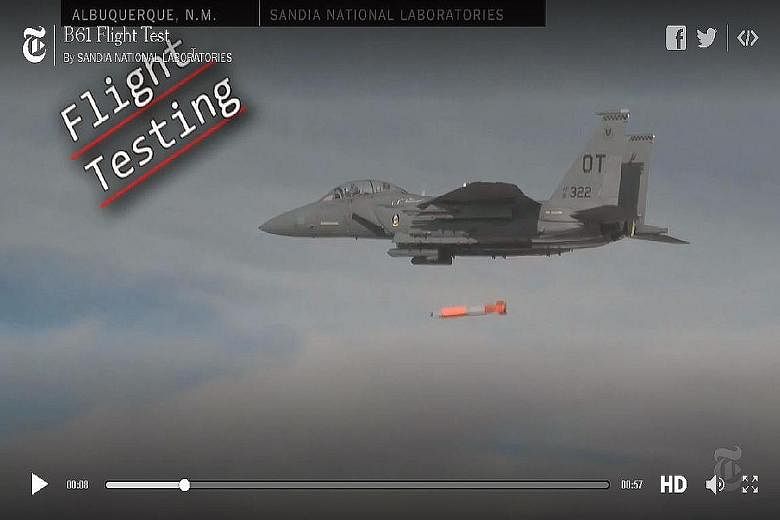NEW YORK • As North Korea dug tunnels at its nuclear test site last year, watched by US spy satellites, the Obama administration was preparing a test of its own in the Nevada desert.
A fighter jet took off with a mock version of the nation's first precision-guided atom bomb. Adapted from an older weapon, it was designed with problems like North Korea in mind: Its computer brain and four manoeuvrable fins let it zero in on deeply buried targets like testing tunnels and weapon sites. And its yield, the bomb's explosive force, can be dialled up or down depending on the target, to minimise collateral damage.
In short, while the North Koreans have been thinking big - claiming to have built a hydrogen bomb, a boast that experts dismiss as wildly exaggerated - the Energy Department and the Pentagon have been readying a line of weapons that heads in the opposite direction.
The build-it-smaller approach has set off a philosophical clash among those in Washington who think about the unthinkable.
President Barack Obama has long advocated a "nuclear-free world". His lieutenants argue that modernising existing weapons can produce a smaller and more reliable arsenal while making their use less likely because of the threat they can pose.

The changes, they say, are improvements rather than wholesale redesigns, fulfilling Mr Obama's 2009 pledge to make no new nuclear arms, a vow cited by the Nobel committee that year in awarding him the Peace Prize.
But critics, including a number of former Obama administration officials, argue that the explosive innards of the revitalised weapons may not be entirely new, but the smaller yields and better targeting can make the arms more tempting to use - even to use first, rather than in retaliation.
General James Cartwright, a retired vice-chairman of the Joint Chiefs of Staff who was among Mr Obama's most influential nuclear strategists, said he backed the upgrades because precise targeting allowed the United States to hold fewer weapons.
But "what going smaller does," he acknowledged, "is to make the weapon more thinkable".
As Mr Obama enters his final year in office, the debate has deep implications for military strategy, federal spending and his legacy.
The B61 Model 12, the bomb flight-tested last year in Nevada, is the first of five new warhead types planned as part of an atomic revitalisation estimated to cost up to US$1 trillion (S$1.4 trillion) over three decades. As a family, the weapons and their delivery systems move towards the small, the stealthy and the precise.
Already there are hints of a new arms race. Russia called the B61 tests "irresponsible" and "openly provocative". China is said to be especially worried about plans for a nuclear-tipped cruise missile. And North Korea last week defended its pursuit of a hydrogen bomb by describing the "ever-growing nuclear threat" from the United States.
In an interview, Mr James Miller, who helped develop the modernisation plan before leaving his post as under-secretary of defence for policy in 2014, said the smaller, more precise weapons would maintain the nation's nuclear deterrent while reducing risks for civilians near foreign military targets.
"Though not everyone agrees, I think it's the right way to proceed," he said. "Minimising civilian casualties if deterrence fails is both a more credible and a more ethical approach."
NEW YORK TIMES

